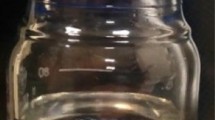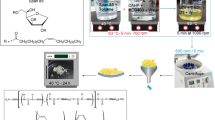Abstract
The differential scanning calorimetry (DSC) technique was demonstrated to be a reliable and fast tool for the investigation of the selective impregnation of archaeological woods with poly(ethylene) glycols (PEGs) mixtures. To this aim, waterlogged archaeological woods were impregnated by using aqueous mixtures of PEG 4000 and PEG 400 as well as mixtures of these polymers in the melt state. The efficiency of the treatments was also estimated by determining the total consolidant content entrapped into the cavities of degraded wood by means of DSC and thermogravimetry.






Similar content being viewed by others
References
Pearson C. Conservation of marine archaeological objects. Michigan: Butterworths; 1987.
Hoffmann P. On the stabilization of waterlogged softwoods with polyethylene glycol (PEG). Four species from China and Korea. Holzforschung. 2009;44:87–93.
Hoffmann P. On the stabilization of waterlogged oakwood with PEG. II. Designing a two-step treatment for multi-quality timbers. Stud Conserv. 1986;31:103–13.
Hoffmann P. To be and to continue being a cog: the conservation of the Bremen Cog of 1380. Int J Naut Archaeol. 2001;30:129–40.
Cavallaro G, Donato DI, Lazzara G, Milioto S. A comparative thermogravimetric study of waterlogged archaeological and sound woods. J Therm Anal Calorim. 2011;104:451–7.
Hoffmann P, Singh A, Kim YS, Wi SG, Kim IJ, Schmitt U. The Bremen Cog of 1380—an electron microscopic study of its degraded wood before and after stabilization with PEG. Holzforschung. 2004;58:211–8.
Donato D, Lazzara G, Milioto S. Thermogravimetric analysis. J Therm Anal Calorim. 2010;101:1085–91.
Bugani S, Modugno F, Łucejko J, Giachi G, Cagno S, Cloetens P, Janssens K, Morselli L. Study on the impregnation of archaeological waterlogged wood with consolidation treatments using synchrotron radiation microtomography. Anal Bioanal Chem. 2009;395:1977–85.
Terekhova IV, Romanova AO, Kumeev RS, Fedorov MV. Selective Na+/K+ effects on the formation of α-cyclodextrin complexes with aromatic carboxylic acids: competition for the guest. J Phys Chem B. 2010;114:12607–13.
De Lisi R, Lazzara G, Milioto S. Temperature-controlled poly(propylene) glycol hydrophobicity on the formation of inclusion complexes with modified cyclodextrins. A DSC and ITC study. Phys Chem Chem Phys. 2011;13:12571–7.
De Lisi R, Giammona G, Lazzara G, Milioto S. Copolymers sensitive to temperature and pH in water and in water + oil mixtures: a DSC, ITC and volumetric study. J Colloid Interf Sci. 2011;354:749–57.
Lazzara G, Milioto S, Muratore N. Solubilization of an organic solute in aqueous solutions of unimeric block copolymers and their mixtures with monomeric surfactant: volume, surface tension, differential scanning calorimetry, viscosity, and fluorescence spectroscopy studies. J Phys Chem B. 2008;112:5616–25.
De Lisi R, Lazzara G. Aggregation in aqueous media of tri-block copolymers tuned by the molecular selectivity of cyclodextrins. J Therm Anal Calorim. 2009;97:797–803.
Tiné M, Alderighi M, Duce C, Ghezzi L, Solaro R. Effect of temperature on self-assembly of an ionic tetrapeptide. J Therm Anal Calorim. 2011;103:75–80.
Cavallaro G, Lazzara G, Milioto S. Aqueous phase/nanoparticles interface: hydroxypropyl cellulose adsorption and desorption triggered by temperature and inorganic salts. Soft Matter. 2012;8:3627–33.
Rotaru A, Nicolaescu I, Rotaru P, Neaga C. Thermal characterization of humic acids and other components of raw coal. J Therm Anal Calorim. 2008;92:297–300.
Badea E, Della Gatta G, Budrugeac P. Characterisation and evaluation of the environmental impact on historical parchments by differential scanning calorimetry. J Therm Anal Calorim. 2011;104:495–506.
Lazzara G, Milioto S. Copolymer–cyclodextrin inclusion complexes in water and in the solid state. A physico-chemical study. J Phys Chem B. 2008;112:11887–95.
De Lisi R, Lazzara G, Milioto S, Muratore N. Laponite clay in homopolymer and tri-block copolymer matrices. J Therm Anal Calorim. 2007;87:61–7.
Giachi G, Capretti C, Macchioni N, Pizzo B, Donato ID. A methodological approach in the evaluation of the efficacy of treatments for the dimensional stabilisation of waterlogged archaeological wood. J Cult Herit. 2010;11:91–101.
Hoffmann P. On the long-term visco-elastic behaviour of polyethylene glycol (PEG) impregnated archaeological oak wood. Holzforschung. 2010;64:725–8.
Sivalingam G, Karthik R, Madras G. Blends of poly(ε-caprolactone) and poly(vinyl acetate): mechanical properties and thermal degradation. Polym Degrad Stab. 2004;84:345–51.
Sivalingam G, Madras G. Thermal degradation of binary physical mixtures and copolymers of poly(ε-caprolactone), poly(d,l-lactide), poly(glycolide). Polym Degrad Stab. 2004;84:393–8.
Kubo S, Kadla JF. Effect of poly(ethylene oxide) molecular mass on miscibility and hydrogen bonding with lignin. Holzforschung. 2006;60:245–52.
Acknowledgements
The study was financially supported by the University of Palermo and COFIN 2008 (Prot. 2008RH3FCW_002).
Author information
Authors and Affiliations
Corresponding author
Rights and permissions
About this article
Cite this article
Cavallaro, G., Donato, D.I., Lazzara, G. et al. Determining the selective impregnation of waterlogged archaeological woods with poly(ethylene) glycols mixtures by differential scanning calorimetry. J Therm Anal Calorim 111, 1449–1455 (2013). https://doi.org/10.1007/s10973-012-2528-7
Received:
Accepted:
Published:
Issue Date:
DOI: https://doi.org/10.1007/s10973-012-2528-7




